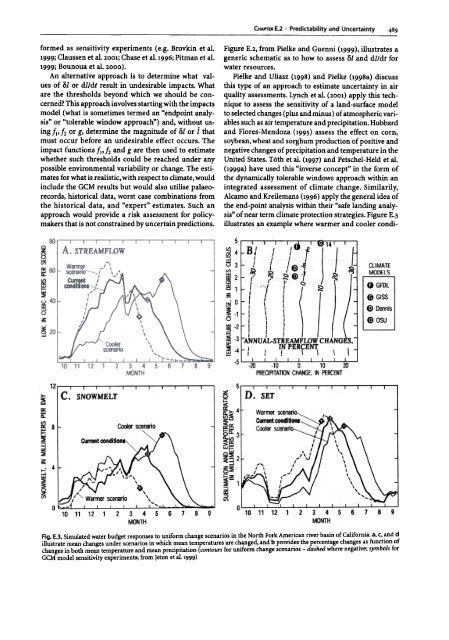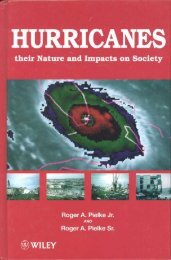How to evaluate vulnerability in changing environmental conditions
How to evaluate vulnerability in changing environmental conditions
How to evaluate vulnerability in changing environmental conditions
Create successful ePaper yourself
Turn your PDF publications into a flip-book with our unique Google optimized e-Paper software.
formed as sensitivity experiments (e.g. Brovk<strong>in</strong> et al.<br />
1999; Claussen et al. 2001; Chase et al. 1996; Pitman et al.<br />
1999; Bounoua et al. 2000).<br />
An alternative approach is <strong>to</strong> determ<strong>in</strong>e what values<br />
of ~I or dI/dt result <strong>in</strong> undesirable impacts. What<br />
are the thresholds beyond which we should be concerned?<br />
This approach <strong>in</strong>volves start<strong>in</strong>g with the impacts<br />
model (what is sometimes termed an "endpo<strong>in</strong>t analysis"<br />
or "<strong>to</strong>lerable w<strong>in</strong>dow approach") and, without us<strong>in</strong>g<br />
II, h or g, determ<strong>in</strong>e the magnitude of ~I or j that<br />
must occur before an undesirable effect occurs. The<br />
impact functions lI,h and g are then used <strong>to</strong> estimate<br />
whether such thresholds could be reached under any<br />
possible <strong>environmental</strong> variability or change. The estimates<br />
for what is realistic, with respect <strong>to</strong> climate, would<br />
<strong>in</strong>clude the GCM results but would also utilise palaeorecords,<br />
his<strong>to</strong>rical data, worst case comb<strong>in</strong>ations from<br />
the his<strong>to</strong>rical data, and "expert" estimates. Such an<br />
approach would provide a risk assessment for policymakers<br />
that is not constra<strong>in</strong>ed by uncerta<strong>in</strong> predictions.<br />
c<br />
§ V)<br />
~""'<br />
Q.<br />
~ ~u<br />
as<br />
:=J<br />
u<br />
~<br />
~<br />
CHAI'TER E.2 .Predictability ilnd Uncerta<strong>in</strong>ty 489<br />
Figure E.2, from Pielke and Guernu (1999), illustrates a<br />
generic schematic as <strong>to</strong> how <strong>to</strong> assess ~I and dI/dt for<br />
water resources.<br />
Pielke and Uliasz (1998) and F'ielke (1998a) discuss<br />
this type of an approach <strong>to</strong> estimate uncerta<strong>in</strong>ty <strong>in</strong> air<br />
quality assessments. Lynch et al. (:~OOI) apply this technique<br />
<strong>to</strong> assess the sensitivity of ;a land-surface model<br />
<strong>to</strong> selected changes (plus and m<strong>in</strong>us) of atmospheric variables<br />
such as air temperature and precipitation. Hubbard<br />
and Flores-Mendoza (1995) assess the effect on corn,<br />
soybean, wheat and sorghum production of positive and<br />
negative changes of precipitation alild temperature <strong>in</strong> the<br />
United States. 16th et al. (1997> and Petschel-Held et al.<br />
(1999a) have used this "<strong>in</strong>verse concept" <strong>in</strong> the form of<br />
the dynamically <strong>to</strong>lerable w<strong>in</strong>dows approach with<strong>in</strong> an<br />
<strong>in</strong>tegrated assessment of climatE: change. Similarily,<br />
Alcamo and Kreilemans (1996) apptly the general idea of<br />
the end-po<strong>in</strong>t analysis with<strong>in</strong> theil' "safe land<strong>in</strong>g analysis"<br />
of near term climate protection strategies. Figure E.3<br />
illustrates an example where warmler and cooler condi-<br />
CLIMATE<br />
MODELS<br />
Fig. E.3. Simulated water budget responses <strong>to</strong> uniform change scenarios <strong>in</strong> the North Fork American river bas<strong>in</strong> of California. a, c, and d<br />
illustrate mean changes under scenarios <strong>in</strong> which mean temperatures are changed, and b provides the percentage changes as function of<br />
changes <strong>in</strong> both mean temperature and mean precipitation (con<strong>to</strong>urs for uniform change scenarios -dashed whl~re negative; symbols for<br />
GCM model sensitivity experiments; from Te<strong>to</strong>n et al.1999)














